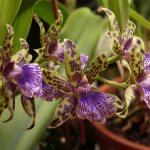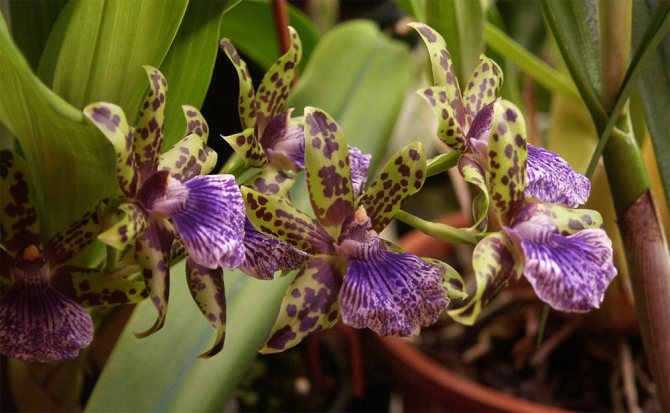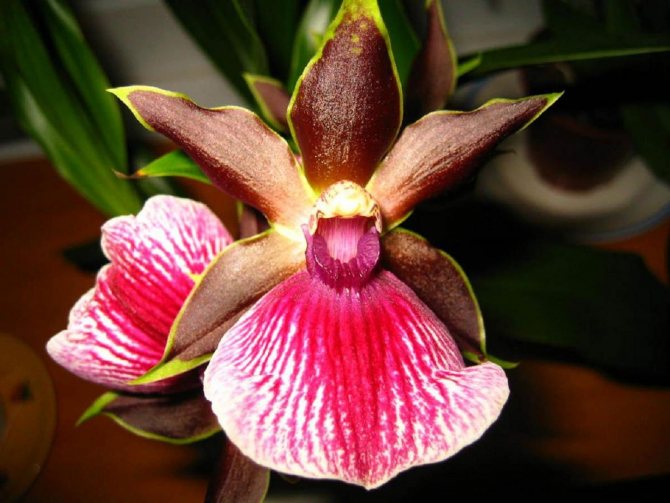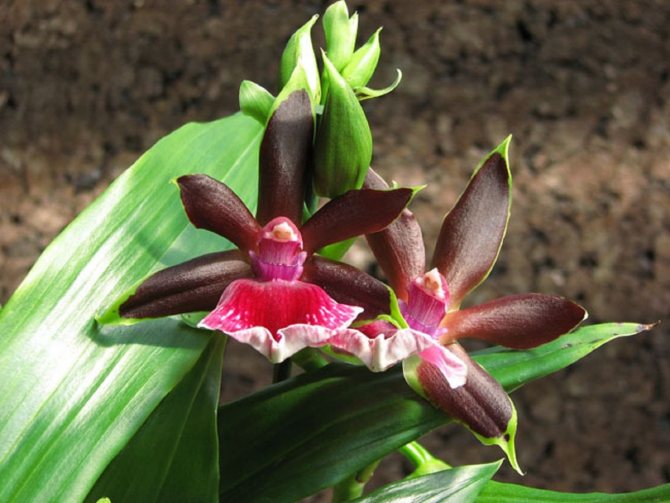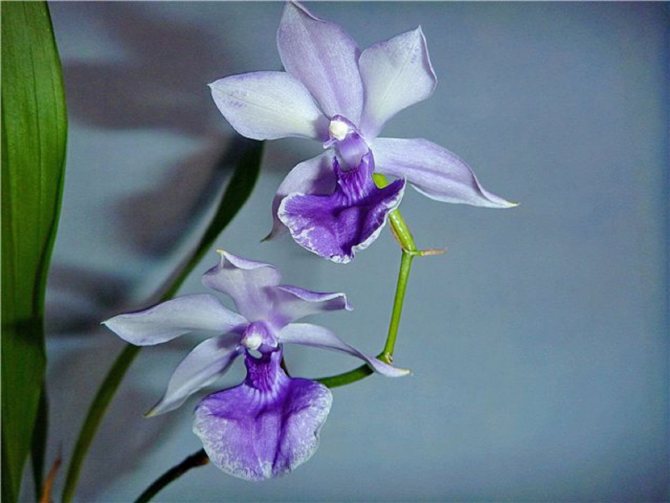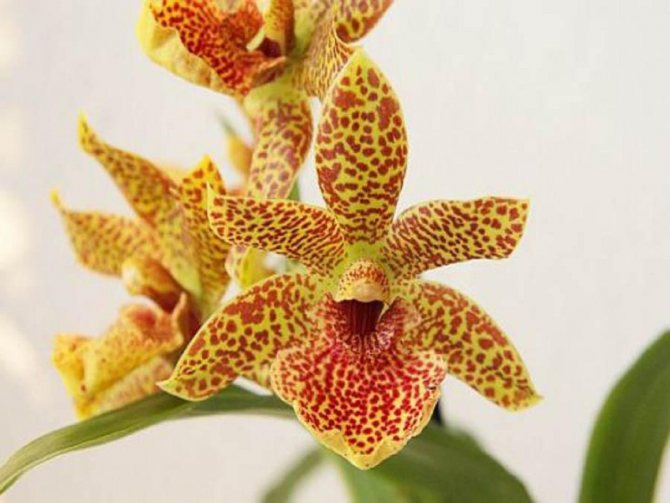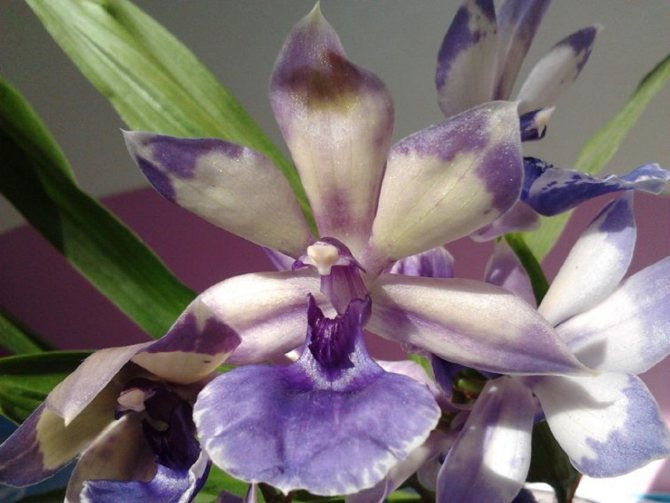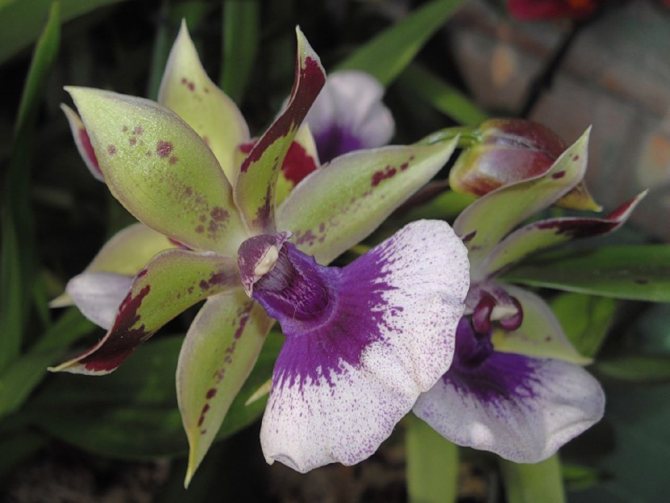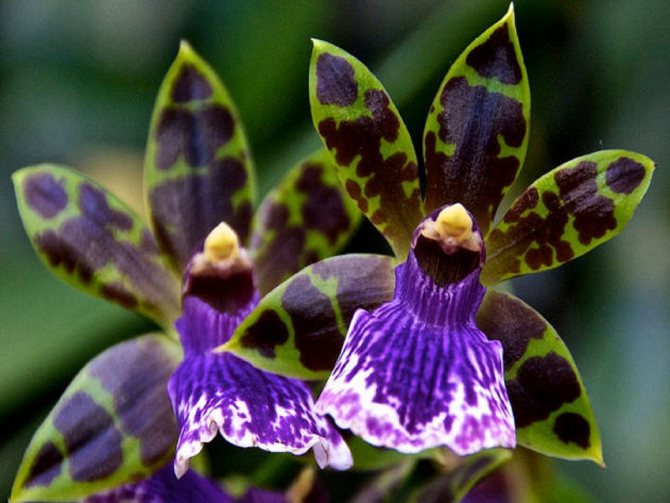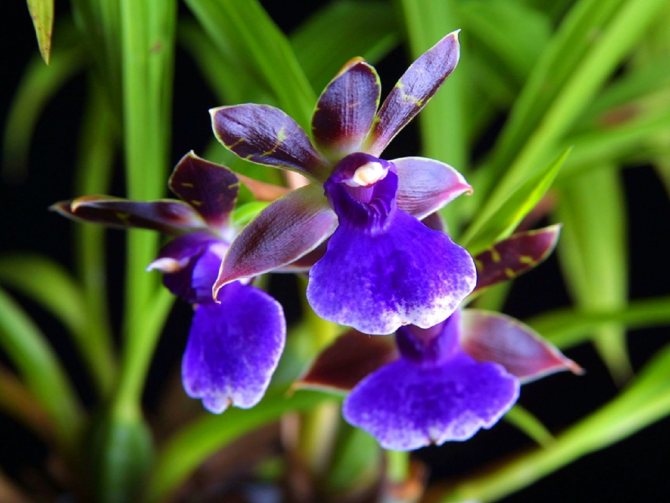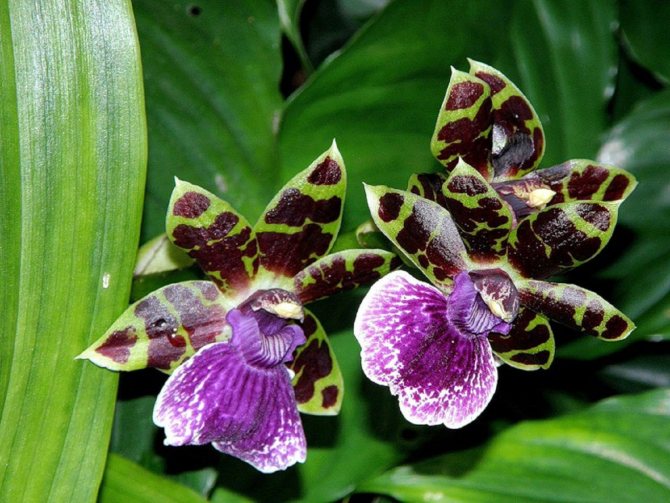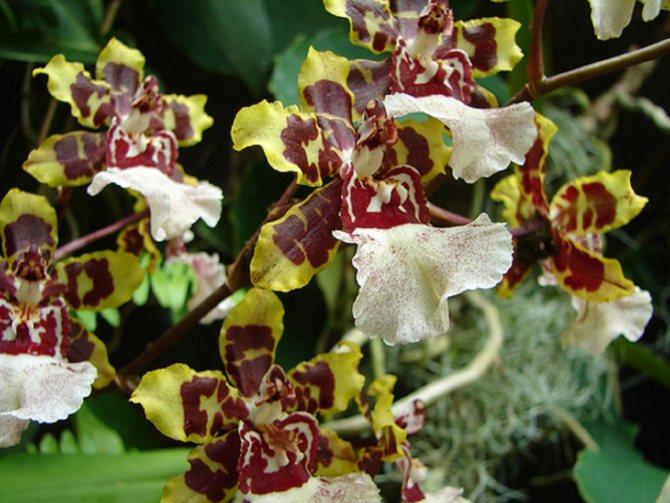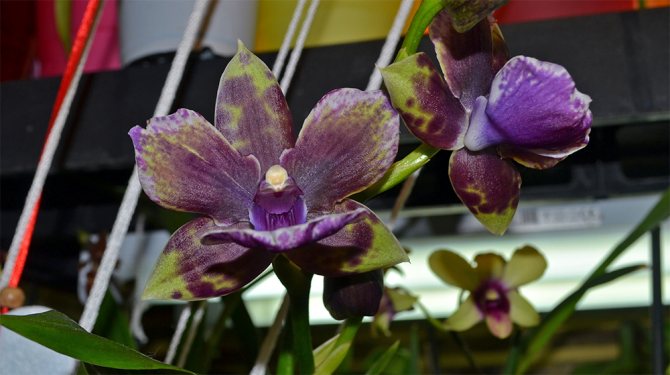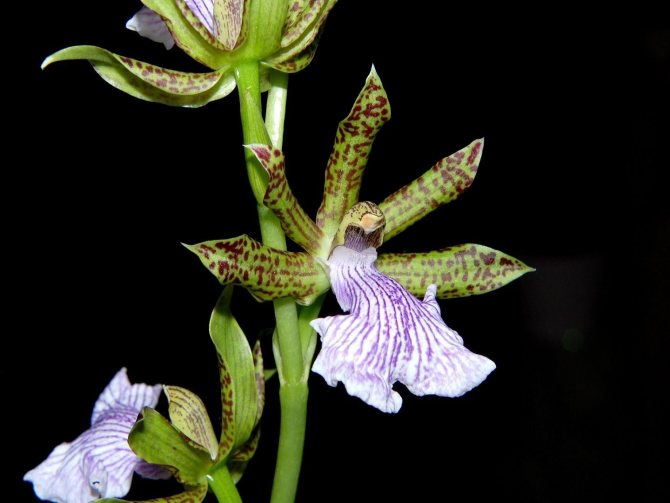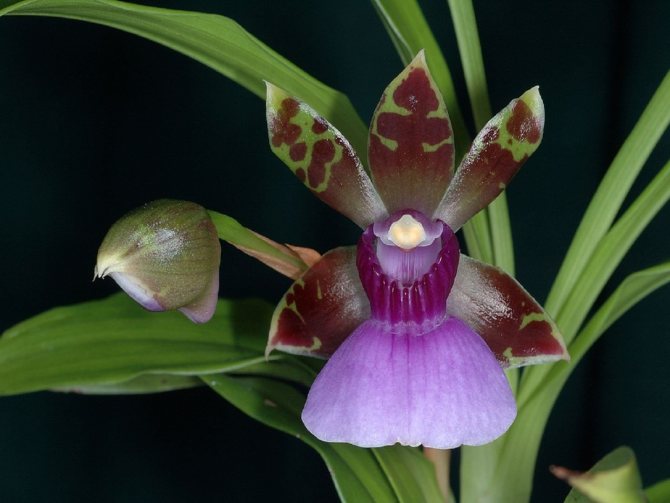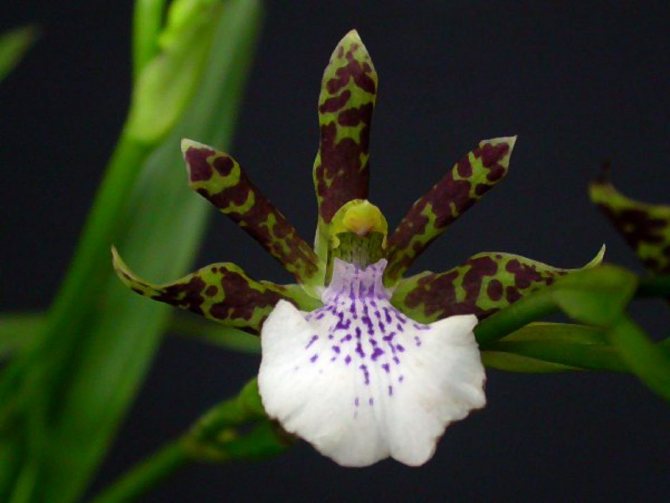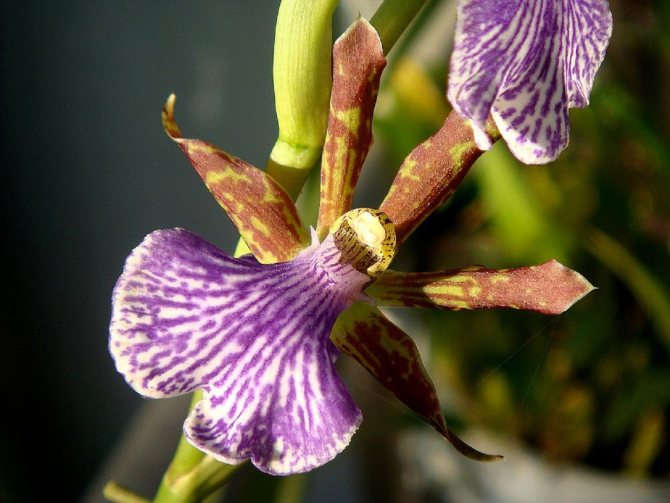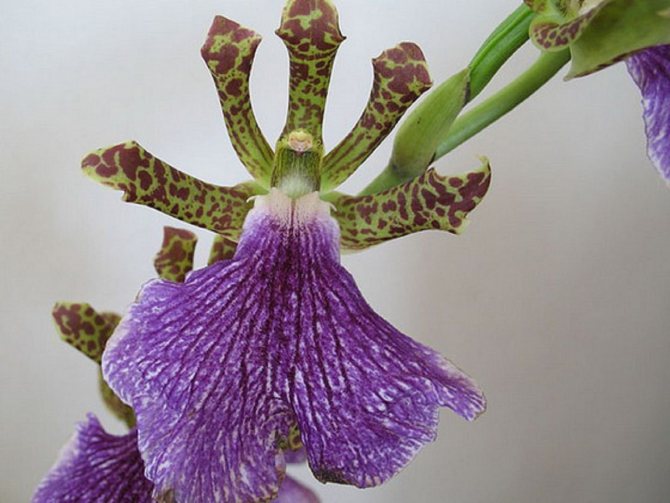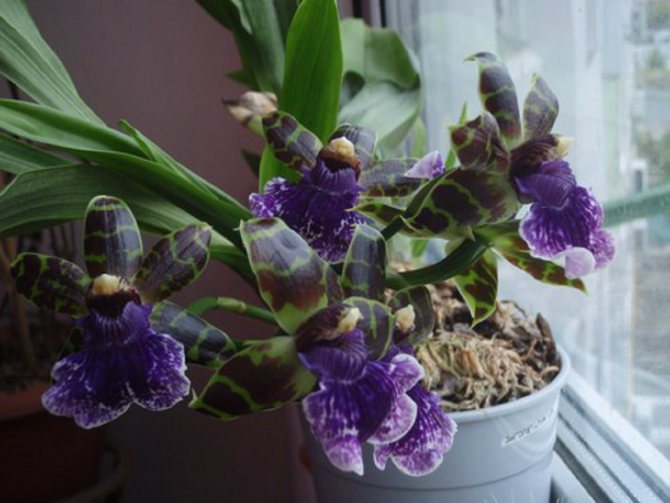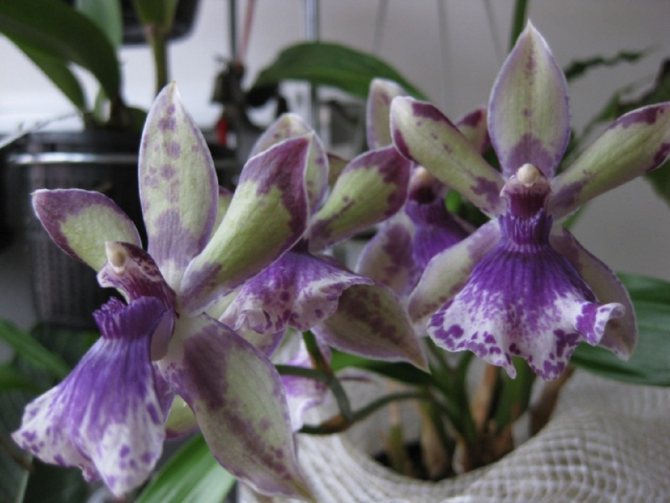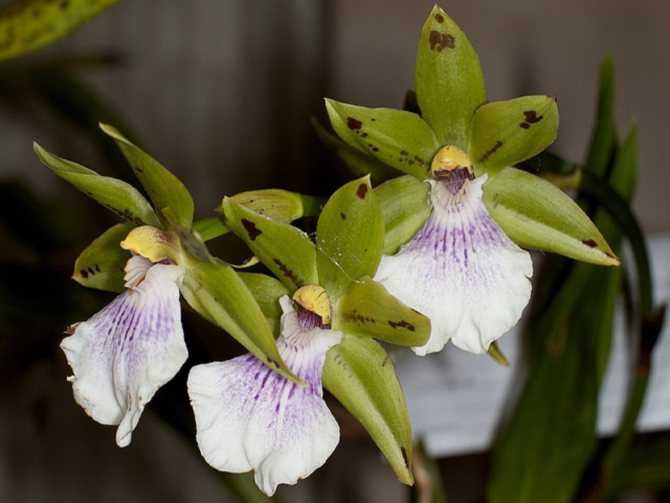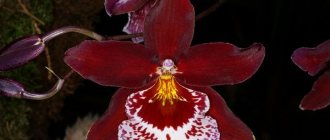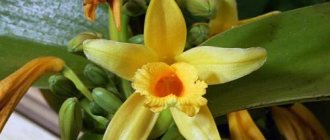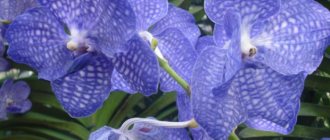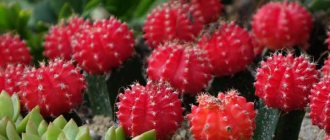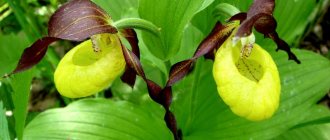A beauty, originally from the South American family of orchids, treated kindly by the famous detective Nero Wolfe. A lady with character, knows her worth. In the plant kingdom, she can easily claim to be Miss Tropics. The owner of flexible, curved shapes. Epiphyte and lithophyte, its high adaptability allows you to feel comfortable on the ground, and on plants, and on rocky rocks. At the same time, it is distinguished by decency, does not drink juices of other plants, and is unpretentious in everyday life. Of short stature, a distinctive feature is that it develops horizontally, not vertically. In the wardrobe, he prefers burgundy, brown, purple, green and white tones. Likes to put on sweet perfumes, especially in the morning. The name is translated as "connecting sepals" or in Greek zygopetalum.
This plant at home pleases the eye with its bright, waxy colors for up to 8 weeks. The peduncle is straight, grows up to 50 cm in length, gives from eight or more flowers, up to 7 cm in diameter. The leaves of the plant are thin with pronounced veins. The genus includes about 30 species that live in the forests of Peru, Mexico, Brazil, Bolivia and Paraguay.
Description and distinctive features
Let's take a closer look and find out what the Zigopetalum orchid looks like: description and home care:
- In the genus Zygopetalum only 15 species... The translation doesn't explain much. They are like "connecting sepals". They are unlike butterflies;
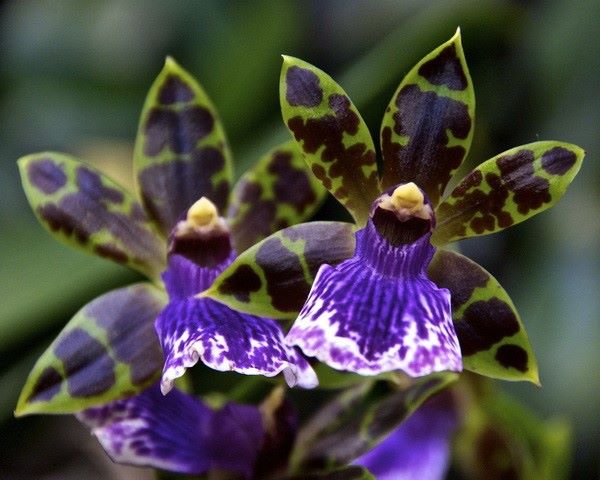
The Zygopetalum Orchid is a very beautiful and rare flower. - This kind even specialists considered small;
- If you like detectives. Nero Wolfe mentions this plant in his works. Here she is "Miss Tropics". Flexible and curved;
- Experts are more inclined to believe that this kind of orchids are rather moody... And they add. As with the entire family, there are no simple ones.
Consider the plant itself:
- It is formed in the form of a ladder shoot. And in a pot, as it were, a nest of several pseudobulbs. New ones appear a little higher and on the side of the old ones. what is a pseudobulb: Orchid stems thickened at the bottom;
- Green, smooth, elliptical (oval) shaped formation;
- 6-7 cm long (high). Flattened.
Please note! On sale flower shops OBI, IKEA will most likely offer you interspecific hybrids - Zygonisia, Zygolum.
What does it look like
The Zygopetalum flower is a type of orchid with glossy petals. Shoots are long, proper planting and care stimulate growth up to 50-70 centimeters in length.The stems are strong, stable, in some situations they break, which indicates emerging diseases that threaten normal development. They are formed in the form of heterogeneous layers - one after another layers are superimposed, an uneven stem is obtained that rises above the ground, which characterizes sympodial growth.
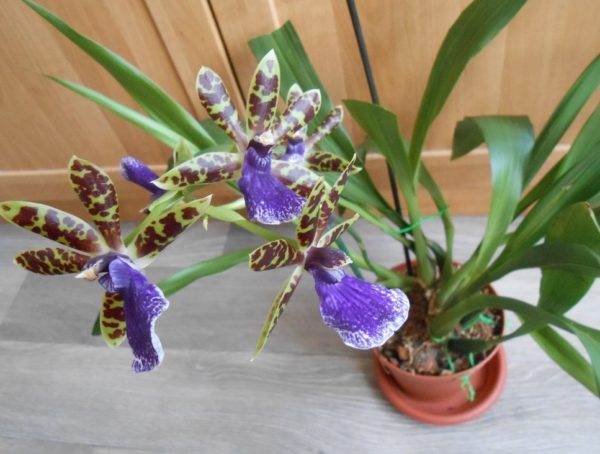

Zygopetalum, the species of which are similar to each other, has a different root system. The roots are mainly white, they are characterized by a special density, an unusual shape - sometimes the roots are so branched that they occupy 90% of the entire pot. In other cases, they are less branched, forming one large, thick root with small branches.
Note. The root system of an orchid is primarily adapted to growing on stones, asphalt, rocks - habitats not entirely suitable for the growth of such a delicate flower.
The branched root allows it to cling to any vertical or horizontal surface, which is why Zygopetalum is often called a parasite. Thanks to these features of growth, the orchid has a peculiar way of feeding - it is enough for the roots to receive moisture from the air, the need for nutrition from the ground is minimized. Usually the function of photosynthesis in plants is performed by leaves, but Zygopetalum is so unique that it is able to organize self-feeding in bright light. To protect against mechanical damage, the root is covered with velamen - a special porous fabric that allows water and light to pass through, but protects against impacts, cuts and other things.
Varieties of Zigopetalum orchids
McKay
- The most famous... Maybe popular;
- His mistresses considered the most beautiful;
- Still would. White lip with purple or reddish streaks and dots;
- Very often used for breeding new varieties... There are already more than 20 of them with her participation.
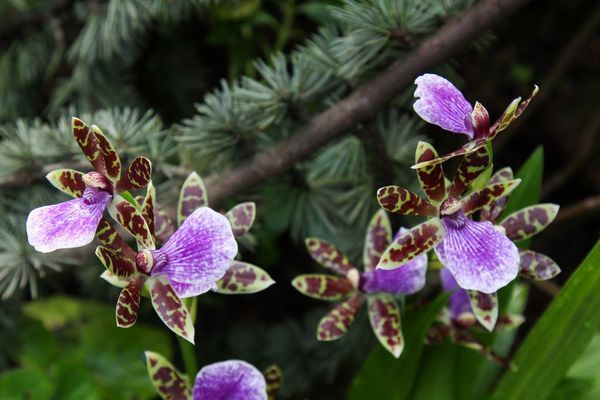

Zygopetalum mackaii.
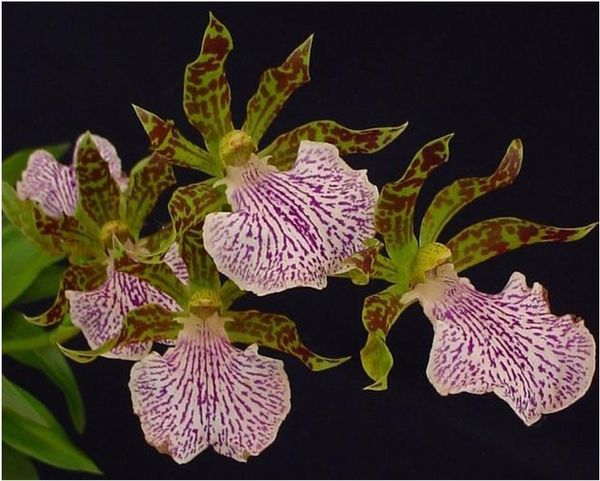

Another McKay.
Maxillare. Zygopetalum maxillare
- The purple color evenly diffuses into a faint purple tint to the edges of the lip;
- Peduncle length reaches 35 cm... Each has 6-8 flowers;
- Burgundy brown almost completely covers green petals at the base.


Z. maxillare.
Blue angel
Those who saw it with their own eyes did not remember the color anymore. And the scent. He reminded them of ground black pepper.
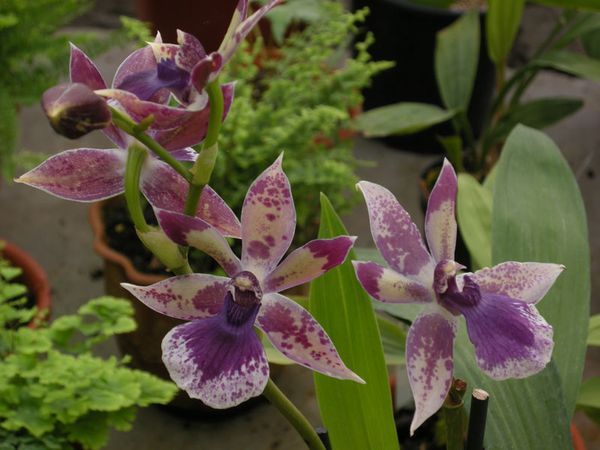

Zyg. Rhein Blue Angel.
Luisendorf. Zygopetalum Louisendorf
Highly sweet flavor... They even carry him out of the bedroom. Ardent lovers of these flowers.
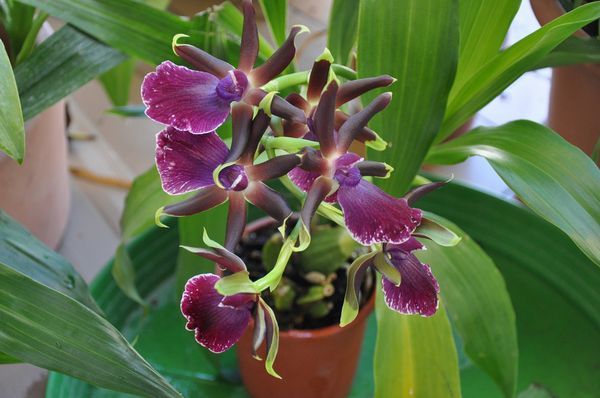

Zig. Louisendorf.
Varieties and hybrids
In the assortment of flower shops, you can find several types of zygopetalum. Buyers should be aware that the principles of care and cultivation for all of them remain the same, the differences relate only to the appearance, timing, abundance and duration of flowering.


The most common types and varieties:
- McKay... An epiphyte that retains a bright color of foliage throughout the year. Due to its high adaptability, many new forms with interesting patterns of inflorescences have been bred on the basis of this variety. The brightest of them - with green petals dotted with brownish spots on thin sepals, and the "lip" is painted white with purple or red inclusions. The outer edge of the "lip" is wavy, which gives the flower a delicacy.
- Waste... A variety with a high flowering shoot protruding 40 cm above the vegetative part, on which there are 8-12 inflorescences. After opening, the buds reach a diameter of up to 5 cm. Narrow petals are widened to the outer edge and have a light green color with brown specks, while the “lip” remains white with thick purple or lilac stripes.
- Maxillare... An orchid with a small flowering shoot, on which buds of up to 8 pieces are densely concentrated. The greenish background color of the petals is visible only along the outer edge, while the center is filled with brown or burgundy. The lower wide part smoothly passes from dark to light purple, and in rare cases - to white.
- Troy blue... One of the most popular and beautiful hybrids with a high price tag.It has very thin elongated foliage and unusual inflorescences, in which thinner and thicker petals alternate. The colors are yellow-violet, yellow-blue or white with burgundy splashes.
- Pedicellatum... A distinctive feature is an uncharacteristic narrow white "lip" along which purple dots are randomly located.
- Tristy... The variety has a peduncle shortened to 25 cm, which is hidden in the foliage. It differs from other varieties by a large diameter of flowers - 6 cm, there are no more than 6-7 of them on one shoot. The upper part is painted in burgundy, and the lower part is whitish with purple veins.
- Pabstia... The largest member of the genus, growing up to 90 cm in height. The size of the buds is also striking, when opened, their diameter is 10 cm. The coloring is standard with a predominance of brown-red and purple shades.
- Microfitum... A dwarf variety that does not exceed 15-25 cm in height, which is very convenient when growing in a confined space. A large number of miniature buds have a long flowering period.
- Blue angel... The main characteristic is the presence of a special aroma with hints of black pepper that surrounds the plant during flowering. Despite the increased moodiness and difficulty in care, it is loved by flower growers because of the beautiful lilac-blue coloring with cream shades.
- Luisendorf. One of the most popular varieties of all orchids. Earned love for the sweet floral scent that surrounds the zygopetalum as the buds open. In the morning hours and an hour or two before the start of rain, the aroma intensifies.
Homeland and territory of distribution in nature
The nature of South America has endowed everyone with an amazing plant from the orchid family. The whole genus Zygopetalym (zygupetalum). The tropical rainforests of Brazil, Venezuela and Colombia have the most. But they grow:
- In Peru;
- Bolivia;
- Paraguay;
- And Mexico.
They are a curiosity for us. Perfectly feels:
- On the trees;
- Stones;
- Earth.
And no parasite in relation to other plants. In nature it is epiphytic and lithophytic plants:
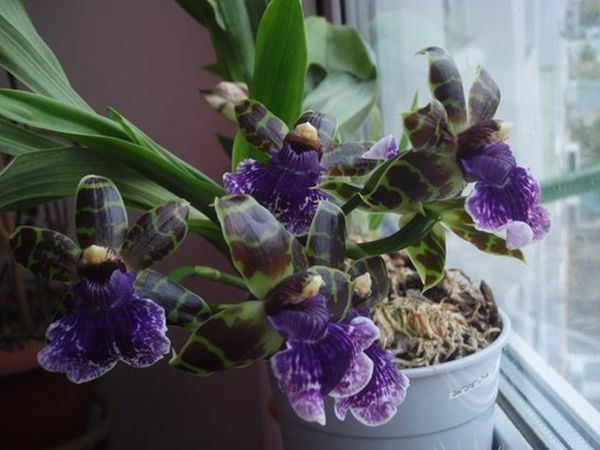

These extraordinary orchids grow on trees, rocks and earth.
- Epiphytes (Greek "on plants") - a plant that grows or is attached to other plants (trunks or branches). And does not receive from them no nutrients... They are not parasitic;
- Lithophytes (from the Greek "stone" and "plant"). Plants that have adapted to life on stones and rocks (dolomites, limestones, marble). More of them in the cracks.
Transfer
This orchid does not need a regular transplant, moving to a new pot will be required when a creeping shoot with pseudobulbs begins to hang from the edge of the container or roots crawl out into all drainage holes and onto the surface of the substrate. In this case, dried or damaged parts are cut off, and the places of the cuts are sprinkled with powder fungicidal preparations or charcoal.
Transplanting at the time of peduncle formation is unacceptable, since stress can cause the plant to shed its buds.
Substrate
The usual soil is not suitable for zygopetalum. It is necessary to purchase a substrate that meets the following requirements:
- permeable and loose;
- with the addition of perlite for better air exchange;
- with vermiculite to prevent caking.
It is best to purchase a high quality ready-made substrate for orchids, consisting of softwood bark, sphagnum and charcoal.
Pot
The main requirement is transparency. This is necessary because the bacteria necessary for normal growth develop on the roots, which only live in the presence of light. It is undesirable to use glass containers, as they can lead to overheating of the root system, and plastic ones will be just right. There must be large drainage holes at the bottom.
Landing technique
A drainage layer with a thickness of at least 5 cm must be laid on the bottom of the pot, after which the roots of the zygopetalum are placed in it and soil is carefully poured into the remaining voids.
The main nuance is that the basal neck and pseudobulbs are not lowered into the substrate, as this can lead to decay during cultivation.
After transplanting, the orchid is watered by immersion in warm water. The first month after this feeding is not carried out.
Testimonials
Natalia. “My story of a grower is like many. There were several pots of violets on the windowsill. Even ordinary watering was not part of my duties. I was not puzzled. And she herself did not show the initiative. Having matured, the attitude towards flowers has changed. These flowers brought coziness and beauty. And now there are flowers in the collection, the names of which many cannot pronounce correctly. Everything does not always work out. There are also miscalculations. Some of them were not even saved.
But there is already solid experience. Including in the maintenance and care of orchids. Many acquaintances ask, consult. I am happy to explain. After my stories, some have acquired their own orchids. Fears of difficult care are a thing of the past. More than a dozen phalaenopsis.
And now the Zygopetalums have already appeared. It is even easier to look after them. And what can you grow without desire? And it doesn't matter that some of them don't have names. They are just white, pink, yellow. Such beauty is worth the effort, effort, money.
So I advise many to put aside doubts about orchids. In fact, everything is much simpler. It is imperative to create the necessary conditions for these beauties. To admire beautiful flowers. It's within your power.
I don't recommend using clay pots. Roots can grow into them. And get damaged during transplants.
I do not recommend buying and transporting orchids in cold winter seasons. "
Alexander. “I already have good experience in growing orchids. Almost ten years. There are now much more opportunities for purchasing them. Take the Internet, for example. Varieties. Care. Everything for growing them (pots, soil, fertilizers). Detailed advice on care. From myself I will notice. Enough and contradictory. For some, they are suitable. I want to share my observations. I water the flowers without immersing the pots in water. I pour it along the edges of the container. Until water flows out of the pot.
I pay special attention to high-quality backlighting. There are many flowers. Lights for each shelf. After the store, I definitely transplant. I select convenient containers. I completely replace the soil. I examine the roots carefully. Dry and damaged must be removed.
Now they love to add coconut flakes to the ground. I delete it. And I advise you. The soil must contain fine coniferous bark, peat, perlite and charcoal. Keep in mind. The roots are fragile and break easily. Be sure to feed with humus fertilizers (Gumat-7). 2 times a month. Without this, flowers cannot be seen.
And remember. The soil must not be allowed to dry completely. They're from the humid tropics. "
Marina. “My friends, orchid lovers and I have come to the same conclusion. Don't be afraid to buy them. Not exactly cheap though. Our conditions allow us to provide them with conditions for flowering. Of course, this must be taken care of. Reading the reviews is also very helpful. There are also many of them: “Oh, I bought such beauty. What is it? And how to continue to be? "
But there are a lot of useful tips. Some of my friends place this orchid on loggias in the summer. Even in the gazebos. And bloom! I want to try it myself.
High humidity (about 60%) needs constant. And I water it often. Moderately. Therefore, I often ventilate the premises. It is necessary to closely monitor the condition of the soil.
Every month I feed them with humus. Be careful with nitrogen fertilizers. They can burn the roots. How can you determine the condition of the soil. And the need for watering. Root color (grayish).The moisture is gone - the weight is lighter.
About lighting and backlights. Too bright lighting contributes to the rapid growth of peduncles. And pseudobulbs are lagging behind and do not have time to ripen. This negatively affects the ability to bloom in the future. Low light conditions prevent them from blooming. We need a golden mean. "
Plant care
Zygopetalum is very easy to care for. This orchid lives in shady and humid tropical forests, so it is enough to create conditions close to natural for it and occasionally water it. The plant is suitable for partial shade or diffused light from the north and east windows. If the leaves of the zygopetalum turn yellow, then there is not enough light for it and the pot should be moved to a more illuminated place or artificial lighting should be used.
Zygopetalum can exist in the temperature range from + 15 ° C to + 25 ° C. For normal growth, it is important to ensure nighttime temperature drops. This helps to form flower buds and actively grow shoots.
On cold days, the orchid is quite capable of adapting to the humidity of the temperate climate, but spraying is recommended in intense heat. Zygopetalum needs intensive watering in the active phase. Water must drain easily, and the soil must dry completely between irrigations. In winter, the frequency of watering is halved.
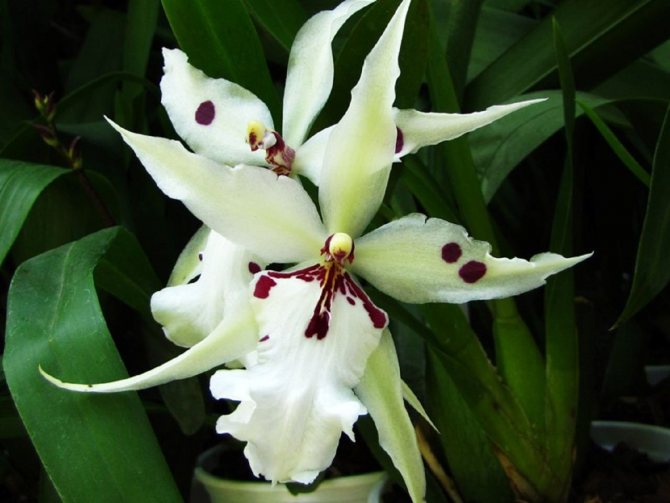

Zygopetalum gets everything it needs from the soil and atmosphere. Only during the flowering period can mineral dressings for orchids be added. A healthy plant needs a half dose of fertilizer.
A transplant is carried out only if absolutely necessary, because any intervention in the root system is very stressful and can cause disease. First, the plant is removed from the pot and freed from the old substrate. If necessary, the bulbs are separated and the dried roots are cut off. All places of cuts are sprinkled with crushed charcoal. For planting, use transparent plastic pots with soil for orchids. Bulbs are placed over the surface of the pot.
How to make a transplant correctly
External characteristics
Specialists-florists, he is ranked among the group of horizontally growing plants.
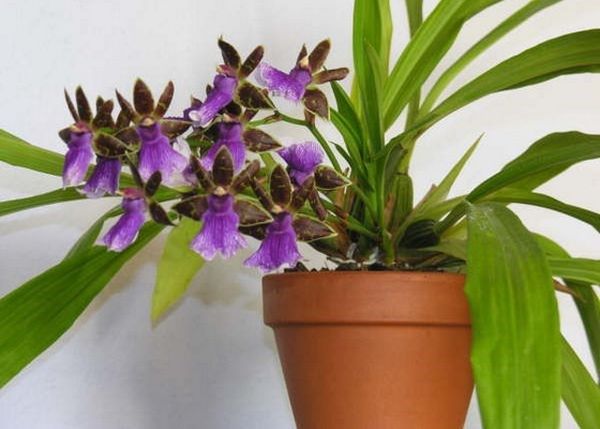

They are called sympodial (from Greek "together" or "many"):
- This orchid has multiple growth points. Shoots grow from them and are transformed into pseudobulbs;
- So they are scattered across the width of the pot. To its edges, in the photo you can observe it;
- United by one rhizome (rhizome);
- From these, as it were, outgrowths, 2-4 leaves grow. And the peduncle.
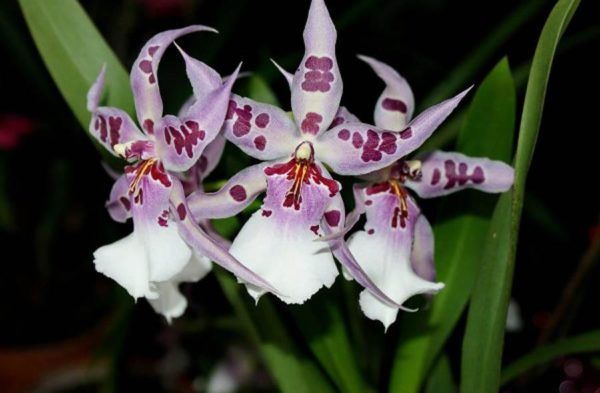

This orchid has several growth points from which several shoots are formed.
On a note! Pseudobulba lives for 2-3 years. Having formed a peduncle, giving him the opportunity to bloom, she herself no longer grows. A new sprout usually appears at the base.
The difference between monopodial orchids (phalaenopsis) is that leaves grow one above the other... And the peduncle grows from the axils of the leaves.
Height of an adult plant
It must be specified. So that they do not mistakenly think that the orchid is creeping. AND find the appropriate place... And the grown leaves and peduncles must bend.
Number of leaves
Quite a lot of leaves are formed... Few people are counting them. But to control the state of the plant, you need to know. From each pseudobulb 2-4 leaves grow. And the bush looks solid.
Maximum peduncle length
And they grow up to 50 cm with proper care and conditions... Can be up to 8 pieces on perennial plants. And each has 6-10 flowers.
You can imagine such a bouquet. You will see - believe it.
Diameter, flower shape
7-8 cm will be exactly. On the ruler. If you measure. The way it is. There is more on the Internet. Especially in the price lists selling companies and entrepreneurs.
But the size is not surprising. And its shape. Five elongated petals by itself. But most of all the lip. Even calls her shovel-shaped... I like the fan comparison better.
Description
The natural habitat of this genus is the tropical regions of America and the forests of Mexico with high levels of humidity. The genus has 15 species, on the basis of which breeders annually develop new varieties and hybrids that amaze with the beauty of flowering and ease of care.
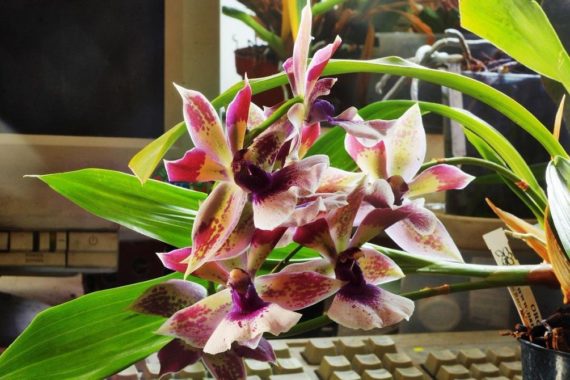

The plant can exist in three forms: epiphyte (growing on the bark of trees, but not feeding on tree sap), lithophyte (with the attachment of the root system to large stones or boulders) and growing on the ground. At the base of the leaf outlet, at the level of attachment to the root shoots, modified pear-shaped stems develop - pseudobulbs, in which moisture and nutrients are stored in case of lack of nutrition from the outside. These formations appear on top of each other, forming a semblance of a horizontal ladder.
Under the pseudobulbs, thick fleshy roots develop, which often take a spiral shape. Depending on the degree of moisture, they can be whitish, gray or whitish-green. The leaves have a rich green color, can be lanceolate or elongated.
Usually these are small orchid plants, reaching a height of 20-30 cm, but there are also large forms up to 90 cm high. The highest part is a flowering shoot, on which flowers 6-7 cm in diameter develop. The color of the petals can be different, from light green to burgundy or lemon with bright spots and stains.
The whole decorative effect of the flower lies in the long flowering, which lasts 7-9 weeks. About 12 inflorescences are formed on the peduncle, in some hybrids there are much more of them. The flowers are complex, consisting of two types of petals: the three upper sepals are thinner and narrower, while the lower ones grow together with the "lip" - a thick, wide petal resembling a fan. Usually the lip is very different in color from the rest of the petals.
The main features of flowering
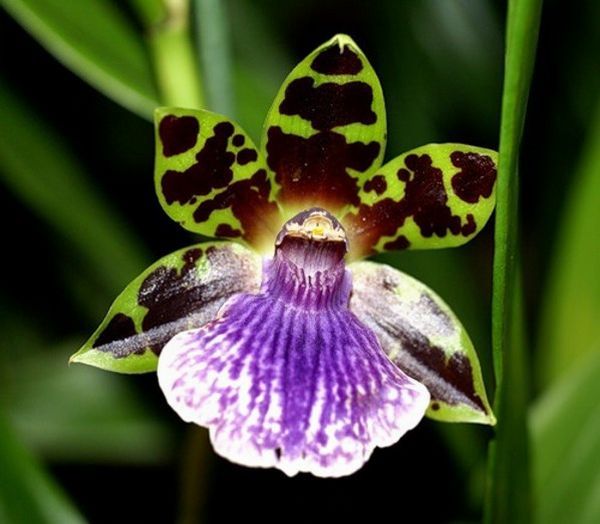

It's hard to understand nature. When does it bloom? How many blooms? Are there these rest periods? What does repeat mean? There are a large number of them. Constant climate... In the tropics, some have just blossomed, while others have already faded. But it blooms on not yet fully formed pseudobulbs.
Period
In an apartment we create conditions ourselves... Two blooms a year. And they were taught to the intervals between flowering (periods of rest). Maybe this is not quite the correct wording.
Duration
I always want to flowering was long... 5-6 weeks you will definitely behold the flowers. On one peduncle. And there how to grow.
Is it possible to repeat?
Amateur flower growers talk about more than repeated flowering. They are their called periodic... And there. Who looked after how. But two flowering a year is considered a great success. At home.
Stimulation
How to stimulate flowering? About this in the reviews most questions... After all, they bought in order to admire the flowers. Not by roots:
- Top dressing with humus is very useful;
- Lowering the temperature to 14-18 degrees, as it were, pushes the plant to this process;
- Reduce lighting time by 2 hours. Within 3-4 weeks.
Flowering and dormant period
At its core, the flowering period is the time of sexual reproduction of plants. Particular attention should be paid to the preparatory stages in order to get healthy and beautiful “offspring”.
Bloom
The zygopetalum flower appears only on fresh, recently grown shoots that have not yet had time to acquire pseudobulbs. The flower stalk always grows next to a bulb that has not yet formed. Indoors, with proper care, it dissolves twice a year.
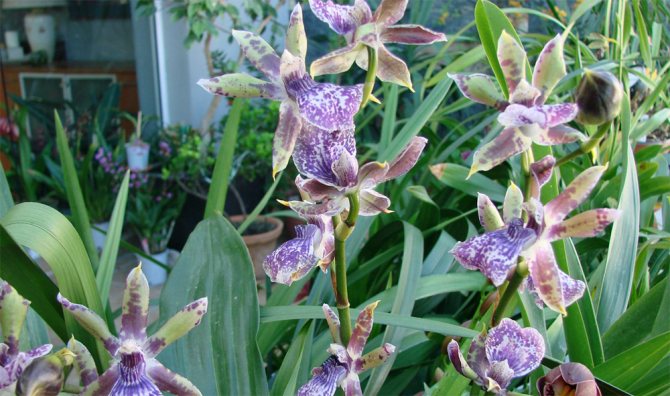

Zygopetalum blooms twice a year.
Dormant period
Under natural conditions, the plant does not feel the need for this. We can talk about the relative dormant period in domestic realities, which occurs after the completion of the growth of new shoots.In order not to disturb your orchid, it is recommended to lower the temperature (during the day to 16-18 degrees, at night to 14-16), as well as reduce watering.
If the habitat of the zygopetalum is a window sill at the northern window, then in winter it can hibernate, since the metabolism will slow down due to a lack of light.
Important! Please note that your "sleeping beauty" practically does not absorb moisture during this period, it only needs a little moisture to the roots. Neighborhood with a battery is contraindicated. As a result of exposure to heat, the plant will begin to "sweat", and since contact with water during this period is limited, this will damage the leaves.
Maintenance and care
Optimal conditions of detention
Home care is a very painstaking job for a beginner. How to keep such an orchid in your apartment. What conditions? Remember. Where did it come from? What are the conditions there? And your hybrids are even more resistant. I would like to convert your attention to two concepts:
- Useful and recommended conditions... When the plants bloom and smell;
- Portable terms... This is when they can withstand unforeseen peaks and jumps without any serious consequences: For zygopetalums, there is no need to be too smart. Wet and cool the setting is fine: More useful during the day 15-25 degrees. And at night about 15 degrees;
- And the rest period in the afternoon is 16-18. And at night 13-16 degrees.
- Pallets with wet expanded clay;
- Neither south nor north. So pick up the southeast. Or just east;
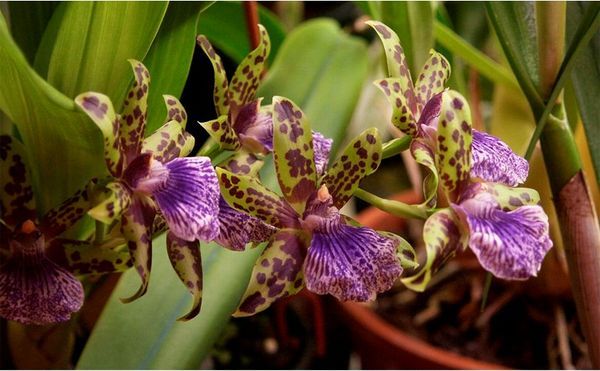

Transfer after purchase in the store
You need to transplant. Although these orchids do not respond very well to transplantation. And what prompts this. You do not know the condition of your plant:
- What are the roots? Refresh and disinfect;
- And the soil in most cases is kind of temporary. And abundantly watered by vendors. In order not to dry out;
- And it's better to change it. Prepare yours. Home.
Watering and feeding
Use two watering options... After the procedure, give the opportunity to dry out. When the roots are covered with velamen. The second option does not involve drying.
Take filtered water... Better rain and settled. Use a distilled and distilled cocktail. Fifty fifty. The salts in the water only harm the leaves. And the roots.
Attention! A bloom (white or yellowish) may appear on the leaves. Can be removed with milk. And the citric acid solution will help.
When blooming water more:
- Usually - once a week. In spring and autumn;
- Once every 3 days in the summer;
- 1 time in 12-15 days - in winter.
Orchidists (or orchomaniacs) advise. Summer watering almost daily... A little bit. Or moderately. It is easier to keep the soil moist.
Watering methods:
- Immerse the pot in water for 15-20 minutes. Set to drain water;
- And all in the morning. Very good every day. Little by little.
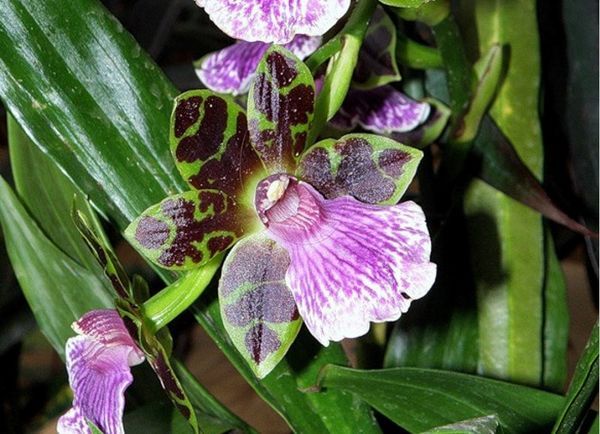

Advice! Do not let the soil dry completely. Let it be slightly damp. As in the tropics.The plant compensates for the lack of moisture from leaves and pseudobulbs. This dehydrates them and prevents them from flowering.
That's really what need to feed, so this is Zygopetalum:
- And not by anything. And more specifically. Humus. Without it, do not dream of blooming;
- Scheme of specialists. Before the appearance of flowers - phosphorus and potassium. After flowering - nitrogen;
- Read the composition of purchased fertilizers! At your discretion and decision - once every 2-3 weeks.
Stimulating flowering
A drop in temperature is not dangerous. And even useful. If it is not essential. It just might promote the emergence of new peduncles.
After flowering, what to do with the arrow?
The flowers are gone. Faded. Evaluate peduncle condition... It starts to dry out. And a pseudobulb. But she should have young shoots. Future pseudobulbs and peduncles. Remove them after drying.
Watering should be reduced. Can be placed in cooler places. To activate the formation of peduncles.
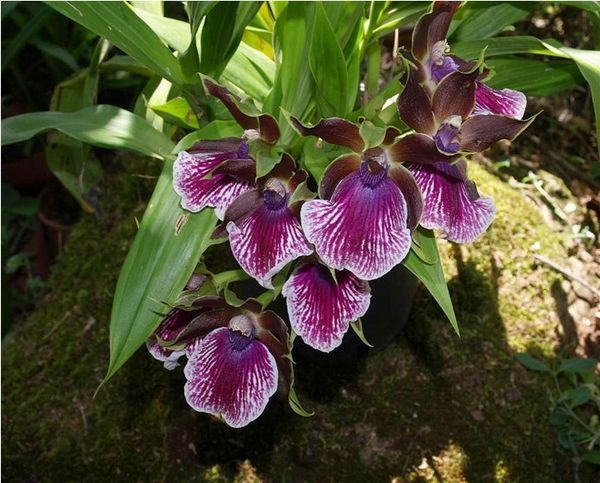

Prevention of diseases and pests
Think about proper care. And provide the necessary conditions:
- Temperature;
- Illumination;
- Humidity;
- Containers for plants;
- Suitable soil;
- Timely watering and feeding and transplanting.
Then you will deal with diseases and pests less. But you need to know them. To timely identify and take action:
- Diseases (about them below);
- Pests. Like regular flowers. Spider mite. A warm shower will help you get rid of it. Repeat it if necessary.
Requirements for soil and feeding
Orchid soil can be purchased at a flower shop.
In order for your flower to grow healthy, you should pay attention to the quality of the soil used. He draws all the necessary "usefulness" from the soil, so it is worth taking care of a balanced and sound "feeding".
Soil for orchids
- moisture-consuming and loose;
- a combination of peat, expanded clay, sphagnum moss and coniferous bark;
- the use of drainage is mandatory;
- add perlite for the airiness of the substrate;
- to protect the soil from caking, use vermiculite.
Necessary feeding
With the exception of the flowering period, fertilization can be carried out for a whole year. Gastronomic preferences of plants are phosphorus and potassium before the flowers appear and nitrogen after. In the active stage, zygopetalum is fertilized once every two or three weeks. Fertilizers should not be too concentrated, as the sensitive roots of the orchid can dry out. Foliar top dressing is also recommended by spraying the outer part of the plant.
Landing
Priming
You already know. The roots of the plant are almost completely in the ground (almost 80-85%). They are covered numerous root hairs... This is what provides the whole plant with moisture. And determines the requirements for the soil. Constantly moist and loose.
Optimal soil composition:
- Finely chopped bark;
- Charcoal;
- Perlite;
- Expanded clay;
- Sphagnum moss;
- Peat;
- The soil should not dry out.
They are also grown on blocks. In greenhouses. There just fit and coconut fibers and a thin layer of moss.
Optimal capacity
Plastic or clay pots. In them, the roots should accommodate freely.
Provide good drainage:
- Expanded clay. Vermiculite;
- And there is at hand. Fine and washed crushed stone. Small sea pebbles. And walnut peels.
Technology and timing
Transplant the orchid only if necessary... For them, this is the period after flowering. Young roots grow more actively. They do not like these orchids to change pots.
The technology is known and not difficult:
- Prepare the container and soil;
- Gently remove the plant from the old pot. As if shaking out;
- Remove old soil;
- Cut off damaged and dried roots and bulbs;
- Charcoal the cuts. And let them dry a little;
- Place the drainage in a pot (expanded clay, perlite);
- Set the plant;
- Cover with soil.
Be careful! Pseudobulbs should be on the surface of the ground.Don't overwhelm them. Once every 3-4 years. Water every other day or two. Not earlier.
Do I need to transplant the zygopetalum orychid after purchase
Despite the negative attitude of orchids to this manipulation, it is still advisable to transplant. You cannot be sure of the quality of the purchased plant's substrate, it mainly consists of peat and its composition leaves much to be desired. It will not be superfluous to examine the root system of the plant. As a rule, sellers in stores subject flowers to abundant watering, naively believing in its effectiveness, although in practice this leads to the death of the roots from a lack of oxygen.
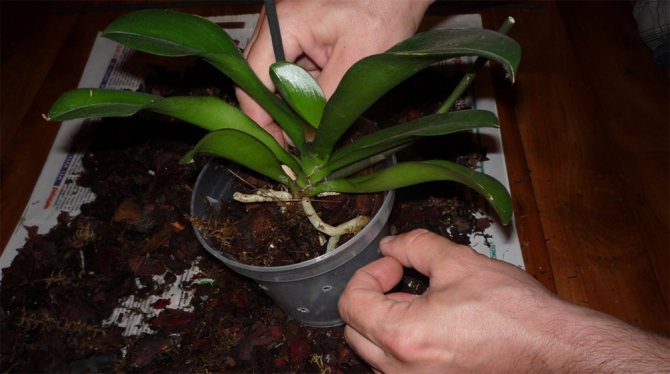

After purchase, the orchid must be transplanted.
Transfer
This manipulation is not in favor with zygopetalums, they do not like to change their place of residence. The transplant should be rather a forced measure, for example, if there is a need for a larger pot or a replacement of the substrate. It is advisable to periodically change the land mixture, since salts accumulate in it, which the orchid is not able to process. Transplanting is possible only after flowering ends. Be careful with pseudobulbs, make sure that they have access to air and are not completely covered with earth. The recommended transplant frequency is once every three years in the spring.
Diseases and their treatment
Yellowing and lethargy of leaves
It can be like a request to improve the illumination. You should consider the options. Based on your conditions and opportunities:
- Backlight;
- Placement on the lighter side.
Black dots on leaves and bulbs
You questions for help:
- Is this not a typical leaf coloring?
- Can the plants stand in the sun? Then sunburn is possible.
Fungal diseases
Very dangerous for orchids fungal disease gray rot... Leaves are covered with dirty spots.
Roots rotted away. How to save?
In order to save an orchid, you must follow the rules:
- Prepare scissors, secateurs. Process them;
- Cut off all damaged parts;
- Process (lubricate) activated carbon slices. Let them dry for 2-3 days. Make sure there is no rot;
- You can equip a mini greenhouse. Or contain in a pot;
- Process possible points root growth with succinic acid solution;
- You can also use vitamins B1, B6, B12. It will take a lot of time. Six months. And patience.
Resuscitation
Sometimes, with improper care or as a result of excessive watering, the zygopetalum completely sheds the leaves, and the bulbs become wrinkled. Even from such an orchid, you can try to grow a healthy plant. To begin with, the bulb is transplanted into a small container with drainage holes. A layer of expanded clay is spread on the bottom, and crushed pine bark is distributed on top. Then the soil is covered with pieces of sphagnum moss.
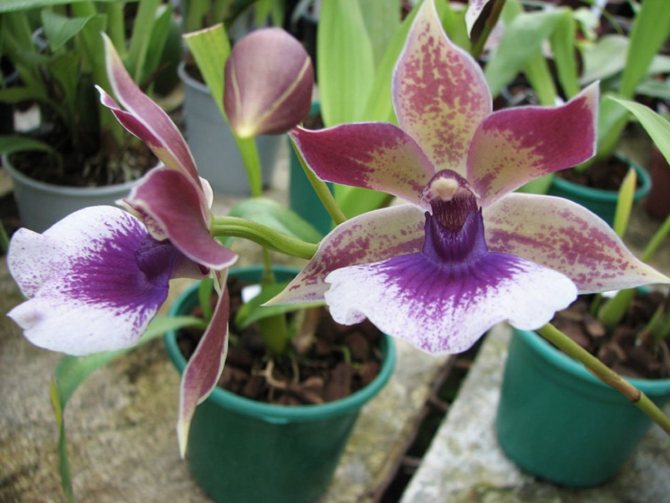

The pot is kept at a temperature of + 18 ... + 20 ° C. For watering, a couple of tablespoons of water along the edge of the pot are enough. The moss will quickly absorb the liquid and distribute it evenly. It may take several months for resuscitation, but if the bulb does not turn black, then a small sprout may appear soon enough.
Reproduction
When grown indoors, Zigopetalum is propagated by dividing the bush. The base of the plant is cut with a sharp knife or pruner, previously disinfected with any disinfectant. The number of divisions depends on the original plant size. Each separated part must contain at least 3 fully matured pseudobulbs. The resulting cuttings are planted in prepared soil.
Tip # 1... If you don't have a fungicide for indoor flowers at hand, you can sprinkle the cuts on the cut with crushed activated carbon. Ordinary wood ash can also be used for this purpose.
Wanda is a hybrid
The progenitors of this hybrid (Vanda and Ascocentrum orchids) are natives of the light tropical forests of Asia and Australia. They prefer high humidity (over 80%) and illumination (30,000-50,000 lux).The flowers, blue in Wanda and orange in Ascocentrum, are very showy, not least due to their impressive size. The flower stalk of a wanda can reach 2 m in height in nature.
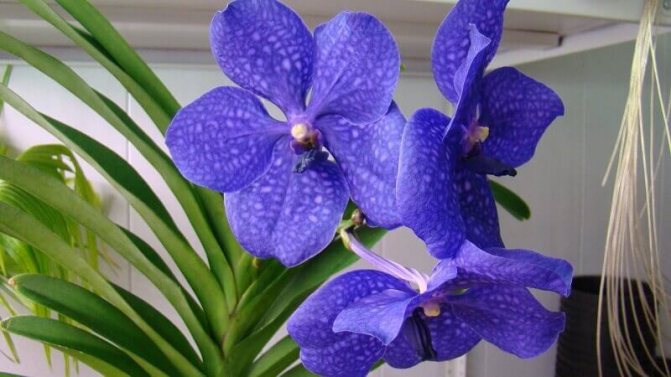

- Growth type: monopodial without pseudobulbs
- Temperature: more than 30 ° С during the day, 18-20 ° С at night
- Daily temperature drops: 2-5 ° С
- Bloom duration: 4-8 weeks
- Bloom time: spring and summer
- Flowering frequency: several times a year, if there is enough light
- Flower color: pink, blue, lilac, red, orange
- Location: veranda, heated conservatory or south window in winter and east or west in summer.
A hybrid of wanda and ascocentrum was named "ascocenda". It has become fashionable to grow it in our latitudes. The flowering of this hybrid is as lush as that of its parents, but the size of the flower is much more modest.
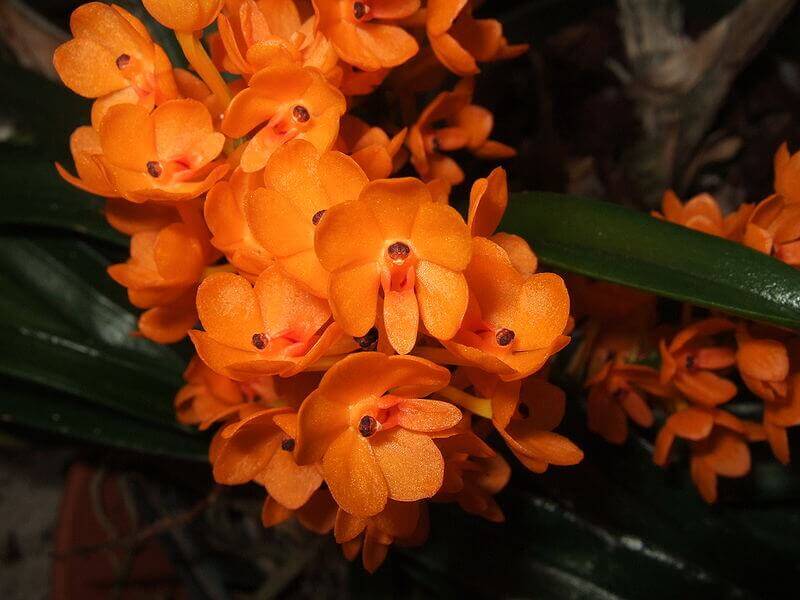

Both genera, as well as their hybrid, have similar conditions of detention. Therefore, we will describe the description of care using the example of the wanda orchid.
Content
- Description
- Zygopetalum care How to care
- Watering
- Fertilizer
- Zygopetalum transplant
- Reproduction of zygopetalum
- Leaving during flowering
- Zygopetalum intermediate
The best varieties
In specialized stores, you can buy interspecific hybrids of this beautiful flower.
One of its main species is Zygopetalum maculatum. The peduncle of the culture grows up to 40 cm in length, 8–12 flowers with a diameter of no more than 5 cm appear on it. Sepals and petals are painted in a characteristic green color with burgundy specks, there are purple stripes on the white lip.
Another interesting species is called Zygopetalum pedicellatum. The plant differs from the previous one in that the wider part of the narrower lip is completely white. In the remaining area, as well as on the surface of the base, small purple dots are clearly visible.
Zygopetalum maxillare is a culture with a peduncle up to 35 cm long and 5–8 large flowers. The sepals are almost completely burgundy-brownish. The lip smoothly changes color: at the tip it is violet-white, at the base it is dark purple.
The varieties of orchids Zygopetalum triste, Zygopetalum pabstii, Zygopetalum microphytum are also worthy of attention of flower growers.
Humidity and watering
The zygopetalum orchid prefers high air humidity - up to 80%. Therefore, it needs frequent spraying. A humidifier will help make this task easier.
The substrate must also be kept constantly moist. You can water zygopetalum using the same method that is used for all orchid plants - by immersing the pot in warm water. In winter, watering can be reduced, which will be visible from the state of the substrate itself.
During active growth, the plant needs frequent watering, but when the pseudobulbs are ripe, it is better to reduce the frequency of watering to prevent rotting and stimulate flowering.
Detailed description
The unusual structure of the flower itself - the petals grow together at the base of the column. The orchid is large, fragrant flowers, have a thick aroma. Flowers are especially fragrant in the early morning.
The length of the shoots reaches half a meter. Sympodial type of growth. A creeping shoot resembles a ladder, with each "step" it gradually rises above the soil. The root system is compacted: white, thick roots.
Pseudobulbs are oblong, shortened, smooth, bright green, oval in shape. They are in a kind of nest from the lower leaves, which die off over time. They usually bear fruit in several flowers. As it grows and develops, each pseudobulb grows slightly higher than the previous one.
The leaves are shiny, pointed, wide, leathery, as if covered with gloss, like a knife - a lancet. They have longitudinal veins.
The flowers are bright: purple, white, green, pointed petals look like starfish. Inflorescences resemble rare brushes.They can have a single color, or they can be dazzling with spots and various patterns. The lip, like a bright brushstroke of the artist's brush, stands out in contrast against the background of the flower itself.
Diseases
The zygopetalum orchid suffers most from rotting of the roots and base of tuberidium when the soil is waterlogged. With minor lesions, the orchid can be saved. To do this, you should reanimate its roots. The rotten pseudobulb must be thrown out so that its rot does not spread to neighboring tuberidia. It is necessary to thoroughly dry a suitable pseudobulb and, if necessary, treat it with a preparation against fungi.
Pests: aphids, spider mites, scale insects. The procedures for their destruction are similar to those used for other orchids.
Zygopetalum transplant
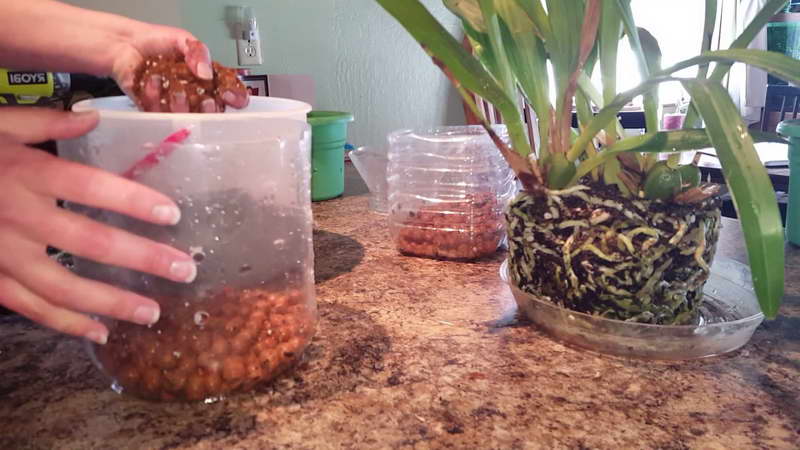

How to transplant zygopetalum photo
In indoor conditions, zygopetalum is best grown in a container filled with a suitable substrate. It should absorb liquid well and allow air to pass through. Most often, flower growers purchase a special substrate for orchids in the store. If desired, prepare the mixture yourself: fine pine bark, sphagnum, expanded clay, peat. The roots of such an orchid can grow into any clay surface, making subsequent transplantation difficult. Better to take a plastic pot, it should have good drainage holes.
On a bark block, zygopetalum is grown mainly in orchidariums or greenhouses, because it will be necessary to maintain a constantly high level of air humidity. The block is a large piece of pine bark. Fasten the roots to the surface of the block, lay a thin layer of coconut fiber or sphagnum on top.
Transplant as needed (when the plant has already grown strongly, the roots have spread beyond the container). Carefully remove the orchid from the substrate, cut off the dried and rotten parts of the roots, treat the cuts with a fungicide. Cut off completely dried pseudobulbs too. If the pseudobulb has simply shrunk and lost its attractiveness, you do not need to cut it - it contains the nutrients the orchid needs to support growth.
When zygopetalum blooms
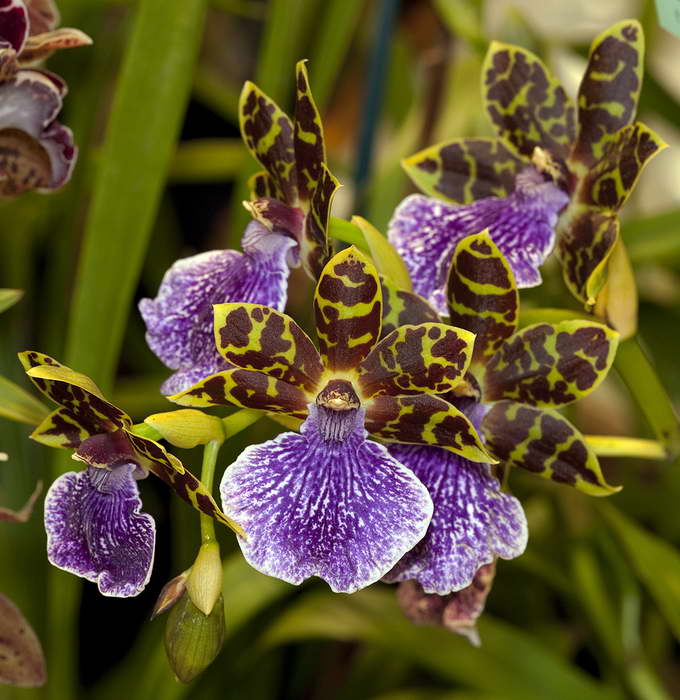

Zygopetalum flowering In the photo, the variety Zygopetalum Kiwi Korker Kutie
The flowering period of the zygopetalum falls on the winter months. With proper care, the orchid will delight you with flowering twice a year.
During the appearance of young pseudobulbs, peduncles begin to grow from the lower leaf sinuses. By the time the pseudobulb ripens, the flowers will already open. The length of the flowering stem is about 60 cm. The inflorescences are racemose, friable, numbering up to 12 flowers. The name of the plant in translation from Greek literally means "petal with petal", which is caused by the fusion of sepals and petals.
Two sepals are obovate at the bottom, they are slightly wider than the third one at the top (it lies on the axis of symmetry). The petals are already of the third sepal. The lip with a wide base, fan-shaped, a horseshoe-shaped protrusion is clearly visible on its surface. Against the background of the corolla, the lip stands out not only in shape, but also in color. Most often it is snow-white, decorated with many longitudinal strokes or long stripes. The color scheme includes purple, pink, greenish, burgundy-brown shades. Petals can be monochromatic or have a variety of patterns, spots.
Zygopetalum is beautiful, original, it can be called the least whimsical to care for among the representatives of the kingdom of orchids. For normal growth, development and flowering, it is necessary to provide conditions as close to natural as possible.
Location and cropping
The roots of the vanda and its hybrids need constant access to air. Therefore, they do not need a substrate. They are often sold in openwork baskets with a bare root system.
Take a vase narrow at the base and widened upward (inverse cone shape).Gently, trying not to break, twist the roots into a spiral, starting from the base of the peduncle. Dip them into the vase. The roots should fill the empty space of the container, so the orchid will anchor in it, as if resting on the walls of the vase.
Submerge the roots in water before placing the orchid in the vase. Wait 20 minutes for them to be saturated with water and turn green and pliable. Cover the roots lightly with moist sphagnum. You can also put some moss on the bottom of the vase.
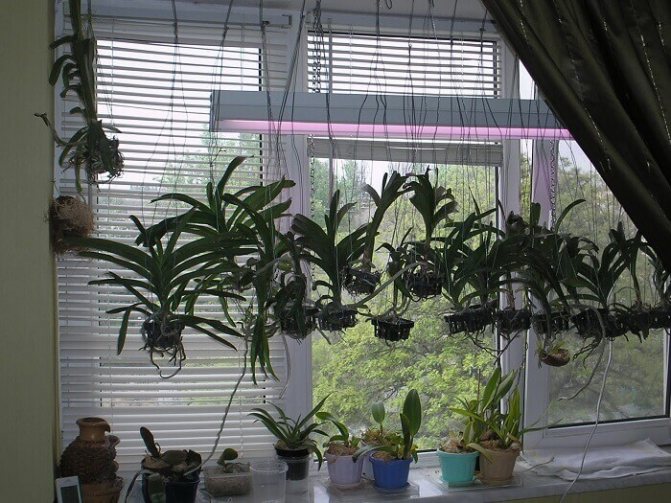

When the flower withers, trim the peduncle at its base. Remove dry or rotten roots with a disinfected pruner from time to time. Cut them as close to the base as possible.
Dark spots on leaves and bulbs
If there is confidence that dark spots are not a decorative feature of an orchid, then you should be on your guard. The appearance of such indicators of the disease is often the result of sunburn. If left immediately after watering on a light windowsill, plants can get sick under the influence of direct rays.
If dirty spots appear on the surface of the leaves, and brown dents on the flowers, this is a sign of fungal infection. This is called "gray rot". A viral infection, which can appear only on the most beautiful part of it, does not bypass the orchid. At the same time, brown or black stripes appear on the flowers.
Botanical description
Zygopetalum (lat.Zygopetalum) is an epiphyte plant. The growth type is sympodial. The genus belongs to the group of Maxillaria orchids and has about 20 species.
A feature of these orchids is the presence of pseudobulbs, which have an oval shape and two leaves.
The leaves are narrow, up to 50 cm long. A long peduncle appears from the axils of a well-ripened young pseudobulb. Zygopetalum blooms during the month in winter.
The flowers are very spectacular, fragrant in diameter up to 6 cm. On one peduncle there can be up to twelve flowers. The petals have a clear mottled pattern. Their color is a combination of green, purple and brown.
Step-by-step instructions for growing
Seat selection
The zygopetalum orchid loves partial shade, so the pots are usually placed on the west or east side. If this is not possible, then it is recommended to use light illumination for the northern location, and the southern windows must be shaded.
A substrate containing humus is also suitable:
- Medium pieces of pine bark.
- Moss is sphagnum.
- Sod land.
- Peat.
- Mullein.
- Dry leaves.
- The drainage layer consists of expanded clay or clay shards.
For growing orchids, it is preferable to use plastic pots. The roots grow strongly, clinging to the surface of the pot, and may be damaged during transplantation. And for ventilation on the side surface in a plastic pot, it is easier to make small holes.
You can also use wooden slatted baskets or other wooden boxes.
Temperature
The temperature regime for the zygopetalum orchid should be moderate:
- Summer time - 23 - 25 ° C during the day and up to 18 ° C at night.
- Autumn-winter period - 18 - 23 ° C during the day, at night up to 15 ° C.
IMPORTANT: It was necessary to observe a daily temperature difference of several degrees.
Temperature limits should be adhered to throughout the year. In the warm season, from spring to early autumn, until night frosts, this orchid can be kept outdoors - in the garden, on a loggia or on an open balcony. Thus, a patient zygopetalum will receive a natural day and night temperature regime with the necessary differences.
Humidity
The required air humidity is high enough - 70 - 90%, in dry weather at least 60% humidity. High air humidity and good circulation are the key to healthy development and growth of the zygopetalum.
Spraying and additional trays with wet pebbles may not always maintain the required humidity. It is better to purchase special artificial humidifiers and steam generators for this orchid.
Lighting
Avoid bright direct sun to avoid dangerous burns on orchid leaves. For zygopetalum soft diffused light is required. It is better to shade the windows with white paper, a curtain, or place the pots away from the windowsills.
If the leaves are a delicate light green color, then the orchid is receiving sufficient lighting. If the leaves have darkened, you need to add backlighting, especially in winter.
Zygopetalum orchids love watering. In summer, watering should be more intense, at this time it is better to add irrigation - spraying and additional moisture - place the pots on a pallet with wet pebbles, put saucers of water near the pots. Florists recommend using a warm shower 2 times a month.
When spraying, water should not fall on the flowers themselves, they may become stained.
Watering is usually done in the morning. In winter, watering is reduced, but you need to monitor the substrate, it should not dry out.
Avoid getting water on young shoots and leaf axils. Rot may appear. After showering, thoroughly wipe the sinuses of the leaves and the outlet itself with a cotton swab.
Water should only be purified, filtered, settled or boiled. Melt or rainwater is also useful. It is impossible to overdry the soil, but it is also impossible to fill in zygopetalum. The substrate should be moist at all times, but it should not stick together.
The watering method is to immerse the pot in a bucket for 20 minutes until it is completely saturated with moisture. Then it is necessary to let the excess water drain into the pan, which we subsequently drain.
Top dressing
We combine fertilization with watering. In the summer - 2 times a week, in the winter it is enough to feed the orchid once a month. During the growth period, fertilizers with nitrogen are used; during flowering, it is better to fertilize with potassium and phosphorus.
Zygopetalum is capricious to excessive artificial feeding, it is possible to destroy the roots. Read the instructions carefully, observe the fertilizer dose.
Spraying with a low concentration of fertilizer can be used for additional fertilization.
Common problems
The main diseases of the zygopetalum are associated with an incorrect watering regime. With regular waterlogging of the soil, the plant is affected by rot, fungus. If signs of decay are found, it is recommended to stop watering, dry the soil, and treat the plant with fungicides.
Of the pests, one has to deal with spider mites. To fight, the plant is bathed under a warm shower, treated with any insecticide. Less common pests are aphids, scale insects. Keeping a flower outdoors in summer sometimes leads to attacks by slugs and snails. But most of the problems are attributed to improper care.
| The leaves of the zygopetalum turn yellow | Insufficient moisture in the air or soil | In the heating season, the flower can be sprayed. It is not recommended to allow the substrate to completely dry out. |
| Black spots on the leaves | Excessive watering. | Watering is temporarily suspended. |
| Lack of flowering | Poor lighting, improperly organized rest period, keeping at high temperatures. | It is recommended to carefully study the rules for keeping a flower during the dormant period. |
| Poor bloom | Overheating of the plant, excess of sunlight. | The orchid should not be kept in the sun, at temperatures above 24 ° C. |
Zygopetalum is not often found in private collections. Many are frightened by the difficulties that arise when growing orchids. But in comparison with other varieties, it differs in unpretentiousness and flowering stability.
Features of transplantation and reproduction
When caring for such a beautiful zygopetalum orchid, be sure to try to propagate it at home.
Reproduction is carried out during transplantation. The plant is divided into two, while each must have at least three pseudobulbs.
After separation, the plants are planted in new containers one third wider than their root system.
Representatives of the Orchid family are not very fond of changing places, therefore, transplantation is carried out very rarely and only when absolutely necessary (in case of illness or lack of space in a flowerpot). You can understand that the pot is too small by the root system, which is visible from the drainage holes. If there are such signs, then it is necessary to transplant the flower.
To do this, the orchid is removed from the flowerpot, this must be done extremely carefully so as not to damage the root system of the flower. Remove the substrate from the roots, you can even rinse them with warm water. Remove all diseased, rotten roots, this will help make the root system more compact. Do not remove shriveled roots, as they contain nutrients that are essential for an epiphytic plant for normal growth and development.
It is very important not to overdry the flower in the summer, as this can negatively affect the roots and foliage of the epiphyte, the fact is that the flower, feeling a lack of moisture, begins to feed on moisture from its own leaves.
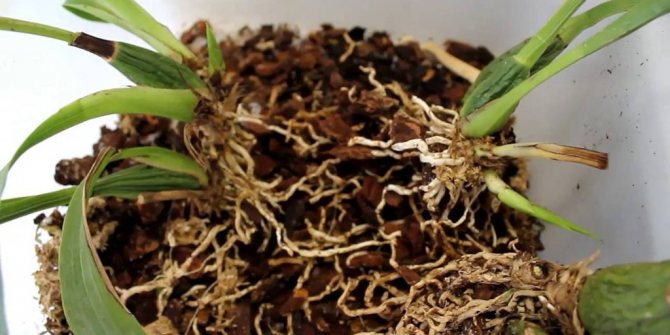

At home, this type of orchid reproduces in only one way: by dividing the rhizome. Moreover, it is necessary to divide it in such a way that each division has at least three fully developed pseudobulbs. Before planting the cuttings in the soil, it is necessary to dry them slightly. After that, the cut points are processed with chiseled charcoal or activated carbon, as a prophylaxis for rot and various kinds of infections.
As a rule, it is enough to separate the bush into parts with three shoots each. If you prefer propagation by cuttings, then take faded stems or parts of pseudobulbs.
Safety precautions:
- disinfection of instruments;
- places of cuts must be sprinkled with crushed coal;
- the substrate must be moist;
- after the procedure, do not fertilize or water the plant, only daily spraying is appropriate.
Temperature and illumination
Zygopetalum prefers shade. The diffused light is reminiscent of the natural habitat.
In winter, however, it is necessary to give the plant more light with fluorescent lamps.
When caring for a zygopetalum orchid at home, temperature plays an important role.
In summer, it should be kept at 20-23 ° C during the day and 15-18 ° C at night. In winter, temperatures can drop to 16-20 ° C and 13-14, respectively.
Reproduction methods
Reproduction of Zygopetalum is possible in several ways:
- Seeds;
- Cloning;
- By dividing the rhizome (rhizome).
In home cultivation, only the latter method is used. The first two are distinguished by complex technology and the need to maintain sterility.
When dividing an orchid, it is important to take into account that for each new plant, it is required to leave from 3 to 4 pseudobulbs. When propagating, you need to pay attention to root shoots and remove damaged roots. Places of cuts, in order to avoid the appearance of rot, are sprinkled with crushed coal, treated with a solution of potassium permanganate or brilliant green.
Before transplanting the slices into separate containers, you need to air dry the slices. After planting in pots, caring for separated flowers is the same as caring for mature plants.
Conditions of detention
The zygopetalum orchid is also unpretentious to lighting conditions. Caring for her in this regard is not difficult at all. Under natural conditions, the orchid grows in the lower tier of the tropics, to which direct sunlight rarely reaches. Therefore, in the apartment, eastern or western windows, as well as the lightest northern windows, are suitable for her. Too bright rays of the sun contribute to the appearance of burns on the leaves and provoke early flowering on new young shoots, which is undesirable.
The leaf blades of this plant can themselves suggest a lack or excess of lighting: a rich green juicy color indicates normal conditions, a yellowish-salad shade is a signal of the need to urgently transfer the plant to a more shaded place in the room.
Mild to moderately cool temperatures are favorite for the zygopetalum orchid. The maximum optimum daytime temperature for an orchid is +25 degrees, the optimum nighttime temperature is + 14-16 degrees.
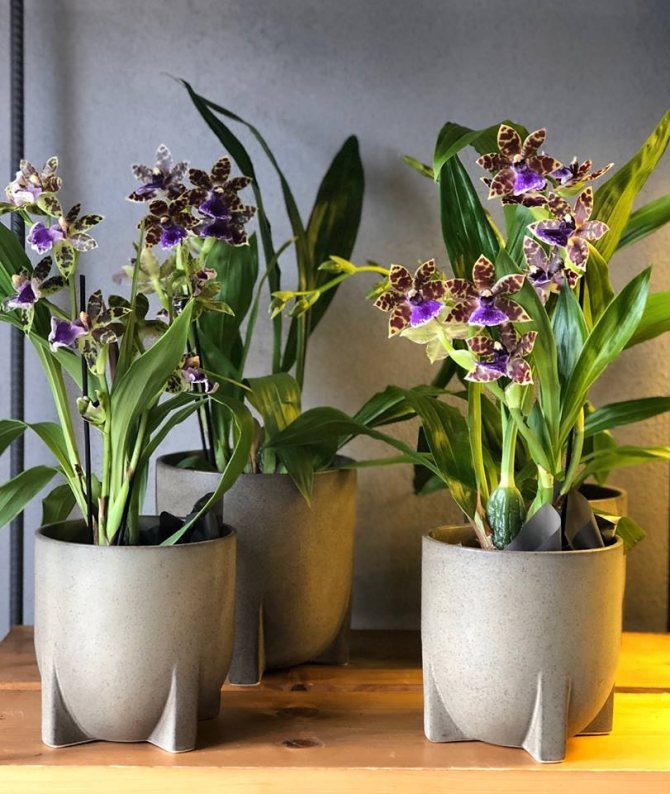

Zygopetalum resuscitation
It happens that home care for the orchid was carried out incorrectly, so the roots begin to rot or dry out completely.
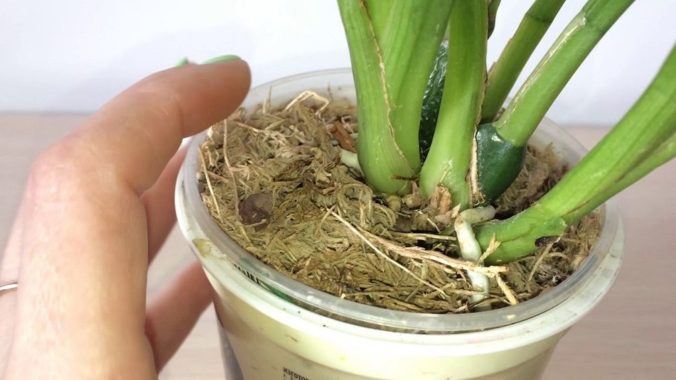

If you can see that the plant is overdried, the leaves have withered and lost their turgor, the pot is immersed in hot water with a temperature of about 40 ° C and left for 30-40 minutes. High water temperature initiates root regeneration.
Another resuscitation method will help in case of decay of the root system. In such cases, the plant must be removed from the pot and all affected roots cut to the base of the pseudobulb. To grow them again, zygopetalum is placed on sphagnum moss. After that, the flower is not watered for the first time, but only sprayed. It's great if every two weeks he is given a bath under a warm shower, after which excess moisture from the foliage is removed with a napkin.
It is good if the foliage is wiped daily with a weak solution of succinic acid. When the first roots appear, very moderate watering begins, which increases as the root system grows.
Adaptation of the orchid to home conditions after purchase
The flower can be found on the shelves of any flower shop. Also, this type of orchid is purchased by many growers from suppliers from Asia, America and Europe. An important step after purchasing an orchid is its adaptation to new conditions. First of all, you should isolate the flower from other plants and place it in a well-lit place.
Next, you need to carefully examine the plant and remove, if necessary, the so-called necrotic particles, which are the source of infections. The remaining healthy cut must be dried. If pests were found on the orchid, they should be dealt with with the help of Judo, Flumite, Apollo preparations. This treatment procedure should be carried out by spraying.
The most important thing during the adaptation period is the thorough restoration of the root zone.
The plant must be planted in a pot filled with new soil, which must necessarily correspond to the size of the root system. The first watering should be done with extremely warm water in the morning.
When adapting, the plant should not be exposed to bright sunlight, it should be kept in moderate conditions and only gradually accustomed to sunlight. The temperature regime should also be without hesitation in the first three weeks after purchase. A successful adaptation process is influenced by the seasons.
Autumn and winter are periods when addiction passes at times slower than in summer and spring. An important indicator of effective adaptation is the emergence of fresh roots on the orchid peduncle; only after their appearance can one resort to the use of fertilizers and plant stimulants.
How to propagate?
You can propagate an orchid by dividing. Each separated part should have 2-3 healthy pseudobulbs. The diagram looks like this:
- clean the roots of soil, cut off rotten and dry roots;
- divide the orchid into several parts;
- sprinkle each part with coal powder, dry in the open air;
- place the seedlings in the moss.
Do not forget about regular watering. Drought will destroy young roots, prevent them from developing normally.

